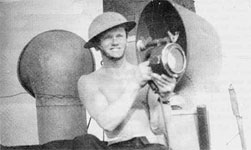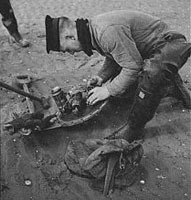| The tough job of clearing of mines and the constant threat of enemy aircraft |
|
I transferred from General Service to the Royal Naval Patrol Service in November 1939 to my first ship HMT "Dalmatia, based at North Shields Fish Quay on December 1939. The Skipper was Andy Lee Telegraphist George Begley, Belfast RNVR. Our duty was routine mine sweeping and keeping convoy routes clear up to the Holy Island (Lindesfarne).
Among Dalmatia's crew in those early days was John Gregson, later to become a famous film star.
John Gregson starred in a couple of well-known feature films which delt with events that happened during the Battle of The Atlantic.
|
|
|
|
|
Most note-worthy was the film The Battle of the River Plate (1957) and co starred Peter Finch & Anthony Quayle. A documentary style account of the trapping, in 1939, of the German Battleship 'Graf Spee' in the South Atlantic by three British Cruisers.
 |
|
Read one of the letters Harold (John) Gregson sent to his to his sister Stella in Liverpool while serving on HMT Dalmatia. |
|
 |
|
|
The arrival of Lt Comdr. Benson (Mersey Division RNVR) saw some changes; I was drafted to HMT Righto. I think a Yeoman Signalman from HMS Dee (an Admiralty Trawler) joined Dalmatia.
Condensing my early history somewhat, I eventually joined Lt Comdr. Benson and Skipper Edwards on HMT Darthema. Eventually Skipper Edwards moved on and we were joined by Sub/Lt Phillip Tull RNVR.
I was the signalman on the H.M.T.Darthema. A large minefield had to be cleared in the vicinity of Beachy Head. We were the leading ship of about eight trawlers, with a drifter laying the `Dan` buoys and sinking any floating mines. Over a period of eight days, a total of forty mines were swept. The climax of this story was that we had been caught in the sweep. All hands were ordered onto the upper works of the ship, whilst the sweep was winched inboard, very slowly. I was watching from the bridge. Suddenly, the mine appeared to leap from the water, only ten feet away from the hull, amidships. We all thought this was it! However, one of the seamen, a giant of a man from the Hebrides, severed the wire with a mighty blow, and sent the remainder of the sweep floating away. The mine was later exploded by rifle fire.
We were attached to the 9th M/S Flotilla, which was equipped with purpose-built minesweepers of shallow draft, with names of seaside resorts like "Bude" and "Rhyl". Whilst they were sweeping ahead of a convoy off Portland we were detailed to protect a merchant vessel with engine trouble. We decided to steam around her in circles, all hands closed up for action.
|
|
|
 |
|
Joe Steele with Aldis lamp, HMT Darthema 1941
Soon, the drone of aircraft was heard. I was searching the sky, then suddenly realised the planes were skimming the waves. I remember to this day, the challenge was `K`, which I made on my aldis lamp, the reply was a hail of bullets, which fortunately were wide. |
 |
|
|
They were nine fighter bombers, Georing`s famous `Yellow Noses`. They flew on toward the convoy, now about two miles away. The two escorting fighters were shot down. A tremendous battle was going on between ships and planes. Suddenly, one of the nine returned from the convoy, flew past us so close I could see the pilot in the cockpit, he seemed to be looking at me. The next moment, he went into a steep climb to about two thousand feet, then screamed down towards us, releasing his bomb, which narrowly missed the merchantman, causing it to almost capsize. Our twelve-pounder crew put a shell just beneath the plane, causing it to leap skywards. The only casualties were the cook of the merchant vessel who was scalded and my aldis lamp which lay shattered on the bridge. I had dropped it very smartly and headed for cover.
The culmination of this story was that a large force of Spitfire and Hurricanes came to assist the convoy, shooting down all but one of the attackers who was last seen limping back to the French coast.
On the trawler, `Darthema`, off the Isle of Wight in the summer of 1941 we found what appeared to be a torpedo floating vertically. We reported this to Mine Recovery at H.M.S. Vernon. A mine recovery officer and two ratings came out to us in a M.L. They decide to ask for volunteers to attach a line to the ring bolt at the head of the object, and then row the boat to the nearby Shanklin beach.
Our Sub-Lieutenant, Philip Jull, took an aldis lamp to communicate with us and together with two seamen set off to the beach with the object in tow.
 |
|
|
 |
|
On the beach, the M.R.O. had organised a squad of soldiers to help haul the object the object up the sandy beach. This was done. The M.R.O. then leaned over the object to have a close look. Suddenly, he ran from it, waving his arms in alarm. Soldiers scattered everywhere. I looked through my binoculars, the beach was deserted. After about five minutes, the M.R.O. and two ratings appeared again and seemed to be working on the object. Eventually, they returned to the `Darthema` and explained that it was some form of mine, which had detonated. We were informed later that it was a type `F` (Tommy) mine, which was a contact type, and if sunk by rifle fire became a deep water magnetic mine. I was told the incident was recorded in the Imperial War Museum. The commander minesweeping forces came out to us, so I presume it was a very important occasion.
|
 |
|
|
I have recorded these events (during my stay on HMT Darthema) in the first edition of "Churchill's Pirates" (author Fred Featherbe ISBN 0-948305 08 8 for those who wish to buy it). However, one episode not recorded in the book, will not leave my memory until I find the name of the ship sunk.
The details as I remember them. Possibly January 1942, sweeping out of Hull or Grimsby, four trawlers. We were attacked by a Ju 88 aircraft, the ship chosen by the bomber I believe, had a 12 pounder in the well of the stern. In the first attack, the plane hit this ship amidships and she started to settle. For some unknown reason he carried a second attack on the same ship, the bomb landing in the stern. The crew managed to lower a boat for the survivors who included the Skipper, though I was told seven were killed.
I would love to know the name of that vessel. Due to an unfortunate incident on "HMT Darthema" we did not fire a single shot during both attacks.
Finally, two people I would like to contact again are Telegraphist George Begley of Belfast and Lt/Comdr Benson of Merseyside. Previous efforts have drawn a blank. Also perhaps Signalman Walter Ross Mersey Division RNVR called up with me in August 1939. We had contact up to Dunkirk.
Joe Steele 2000
|